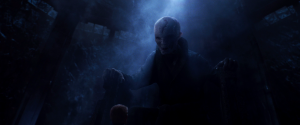For those familiar with my work, you’ll know I like to blend genres. The two most obvious genres in the blend are science fiction and fantasy as I take creatures from legend and use science and sci-fi tropes to explain the various quirks those creatures have. But the third genre I threw into the mix for my books, arguably the most important, was a dash of mystery. Part of this was because the idea first came to me as: “what if vampires really existed, who would police them?” But the other aspect of the decision was that it felt like solving mysteries would give an opportunity to explore the world with a bit more depth. Every detail that my protagonist uncovers or considers while doing his job is, in turn, a detail the audience would learn about the same world. It felt like a natural fit.
So I’ve made it a point over the last several years to do my best to be a student of mystery. Though I always knew the basics and I think I’ve done reasonably well, it’s important to learn new tricks and make sure you’re ahead of your audience a touch. I even shared a few of these tricks in the past as writing tips on this blog. Despite seeming fairly straight forward and even common sense, it’s not as easy as it looks and I’ve known people who struggled with it. There are so many approaches and techniques to delivering a good mystery, and learning all of them and mastering them is something I know will improve my work as I carry on. But not every technique I come across is equal. Some of them are even bad. And one in particular, a fairly popular one depending on which medium you’re looking at, has always proven itself to create more problems than solutions (in fact, as I’ll get into later, that’s by design).
To put it bluntly: I hate the “mystery box”…
Disappointing Gifts

A concept that’s not particularly new but growing in influence over the last decade, the mystery box is an approach to storytelling where the mysterious aspects of something are exaggerated but purposefully left painfully vague in order to incite speculation even if there’s not necessarily an answer or the detail in question isn’t really that important. Particularly common in film and television, this approach essentially uses the curious nature of an audience to fill in the blanks. The idea is that letting your audience’s imaginations run wild will get a better result than you ever could, so you might as well use it to your advantage. And while everyone does this in small doses to some extent (especially if you’re hoping to create suspense), the mystery box philosophy takes it to the extremes and goes beyond simple suspense to outright frustration. And, recently, two sequels showed negative effects of following films that were heavy on the mystery box concept: The Cloverfield Paradox and the Last Jedi.

The Last Jedi in particular has been the focal point of yet another of our internet culture wars. There are a lot of people who see the flaws as being due to ideology, others who see it as a mismanagement of the franchise, and yet others who feel that the problem is a generational gap. George Lucas often said that he took criticism of the prequels and spin-off projects like Clone Wars in stride because he found that someone’s favorite Star Wars was generally the one released when they were a child and, speaking as someone with a nephew who prefers Kylo Ren over Darth Vader, I can say I’ve seen some proof of this. But even among the fans of the movie there were flaws in The Last Jedi that required some acknowledgement. And, though not everything can be pinned on a single person or decision, a lot of common criticisms can be traced back to someone who was’t even involved in the movie: JJ Abrams.

Though he certainly wasn’t the first person to use the concept in story telling, JJ Abrams is a devout believer in the idea of “the mystery box”. In fact, to the best of my knowledge, if he didn’t coin the term he at least popularized it. Describing it during a TED talk, Abrams has made his career off of the very concept of placing mystery boxes in almost every work he’s ever touched and if he isn’t the one who created the term he’s certainly the most successful person to use it. So, as we see similar methods becoming more common, I have to give him credit for at least bringing it to prominence in recent times.
There’s a trope every writer is familiar with called “Chekov’s Gun” – the idea that a sensational element brought into a story has to eventually come to it’s logical conclusion. The original example, the one that named the trope, was that if a gun were to be brought into a story and placed where people could see it, it should eventually be fired. An unfired gun, brought into the story but never actually used, has served no purpose except to be a distraction. Applied to other things, the premise is fairly simple: if you establish an expectation within your audience, you should do what you can to meet that expectation. Applied specifically to a mystery, this is expressed in a fairly simple dynamic – a question must lead to an answer of some form. You can’t meet all expectations, of course, because no two expectations are alike. Everyone will have different ideas of who fires the gun, who gets shot, and why. But eventually someone has to pull that trigger.
That’s not how the mystery box works.
The mystery box, though somewhat similar to Chekov’s Gun, is actually something of an inversion (sometimes even subversion) of the trope. You see, in Chekov’s Gun the result of the gun being there is the point – if the gun doesn’t fire, it was just a distraction. But in a mystery box scenario, the important detail isn’t the effect, it’s the anticipation of the effect. To those who use the mystery box as a tool in their storytelling, at least to the extent of Abrams, the actual results matter less than that anticipation and questions are more important than answers. Using your audience’s anticipation is a good thing, mind you, because it helps you build towards a satisfying conclusion. However, for those who are adherents to the idea of the mystery box, a whole different result often appears…

Because the mystery box is built around the idea that the question is more important than the answer, there need not necessarily be an answer in a mystery box – and sometimes there isn’t. This is where the concept starts to backfire because, eventually, the anticipation high wears off. Audiences need things to pay off, and in the case of mysteries you need to have either provided an answer or provided the audience with enough material for them to come up with an answer of their own. A great example of the second comes from the classic scifi movie Blade Runner (though not the book it was based on) where the question is raised and evidence is shown that the protagonist Deckard may not be human. It’s never blatantly confirmed or denied within the films, but there’s enough material to allow audiences to come up with their own answers. Similarly, a more recent example came when “Inception” begged the question: was he still stuck in a dream? In both of these cases, enough material was provided to the audiences that they could come up with their own conclusions and not feel like there was anything missing. Yes, some people will want to have a definitive answer, but enough of the audience can feel like they know the answer even without confirmation.
The detriment of the mystery box is that rarely does your audience feel like they know anything.
While there are many different opinions on The Last Jedi, one common theme from legitimate critics is that the majority of questions that were raised by The Force Awakens either weren’t answered or were answered in an unsatisfactory fashion. After years of speculation, hopes and expectations, The Last Jedi seemed almost uninterested in addressing what was raised by The Force Awakens. And, here’s the thing, while a lot of people are going to blame the writer and director Rian Johnson, the fact remains that Johnson was put in place to answer questions that Abrams himself originally believed he would never be expected to answer. While Abrams now has control of Episode 9, it must be remembered that when Abrams finished TFA, Episode 9 had a different writer and director slated. There was no intention for him to return to it, he literally left questions without answers and expected other people to fill in the blanks. And in some cases this meant that he left the film with characters that were simply visuals with no backstory.

Regardless of your opinion on how Rian Johnson handled Supreme Leader Snoke, one has to acknowledge that Abrams – who introduced the character – had left him a blank slate for others to fill. The character is mystery box incarnate, a series of unanswered questions left to be speculation fodder with no actual clues. How did he rise to power? Why would he be at the head of this imperial remnant? Was he part of the original empire? What the hell happened to his face?

That’s a lot of questions in a single character, and no one except Abrams really had a fair chance at answering them satisfactorily. And, remember, he originally didn’t plan to return to the franchise. So, while there is buzz about a possible outline, it must be acknowledged that when you look at The Force Awakens in hindsight, given how much of the plot of the movie was lifted from previous entries in the franchise, Abrams’ original contribution was an array of questions without answers – that’s the mystery box.
It’s not that I dislike JJ Abrams either, I was actually a big fan of his movies early on and I’ve previously credited him for rejuvenating Star Trek in film. But the longer I’ve followed his work the more I’ve come to realize he is the most visible example of someone who has abused the mystery box to the detriment of his own stories. I could go on about multiple other examples, but I think it’s fitting that while Star Wars was struggling with the problem, another Abrams franchise released a film also impacted negatively by the mystery box mentality.

The Cloverfield Paradox was a film that was not even meant to be part of the “Cloverfield” franchise. Originally called The God Particle, the original film script was about a scientific experiment causing unexpected results that makes the characters believe they’d accidentally destroyed the Earth. The script had nothing to do with the “Cloverfield” universe and was essentially adapted to fit in with it – having entire concepts added to try to make it fit with this franchise. Because of this, the film didn’t really fit with the expectations of anyone who was watching, it wasn’t really a sequel to Cloverfield or 10 Cloverfield Lane, it was mostly unrelated and the parts that made it connect were forced into the outline. In fact, 10 Cloverfield Lane had been created in the same fashion – taking an unrelated script, changing some details slightly, and slapping the Cloverfield label on it. So in both of these cases you had movies that weren’t related at all being forced in line with a drastically different film. And why? Because Abrams had cornered himself with the mystery box.

The original Cloverfield was built entirely around the mystery box concept right down to its marketing. Originally not even releasing its name, the marketing for Cloverfield started with just a number, a date with no indication of what the date actually meant. Over time details about this concept and this world leaked out and started to craft this ever growing mystery. An alternate reality game of fictional websites and uncovered documents painted this elaborate scenario of conspiracies, freak accidents, and corporate greed. The hype around this film grew from the first details to the release and everyone was eager to find out the answers to all the questions they had. And then, the film released and everyone discovered the truth – the ARG had nothing to do with the plot of the film, and the only connection is that the protagonist was an employee for one of the fictional companies (a detail never mentioned out loud, left as an easter egg in the background). In fact, nothing that was expected was really there – even the monster was only briefly seen and generally at angles where you couldn’t make it out. So, disappointed that the more interesting concept of the ARG was missing, people clamored for a sequel.
But since the entire premise was made of questions that weren’t meant to be answered, there really wasn’t a sequel to be made. Abrams instead started to take other scripts and then adjust them to fit a theme rather than the original story. In The God Particle, however, Abrams’ people were presented with an opportunity. Rewriting the script to include elements that were’t present in the original at all, The God Particle became The Cloverfield Paradox and finally answered one of the questions the original movie posed. The end product was a disjointed mess and not what anyone expected, but it kind of answered the question. And, once again, after a decade of people asking, when they finally got their answer (and, spoiler warning, the scene below is from the end of Cloverfield Paradox)…
https://youtu.be/ztNoxtnarCE
The answer still only managed to raise more questions.
(I write novels, dabble in screenplays, and post stupid shit on twitter. Someday I’d hope to be half as successful as Abrams, but in the meantime I’ll just say: say no to the mystery box, he’s one of only a few who can get away with it)







